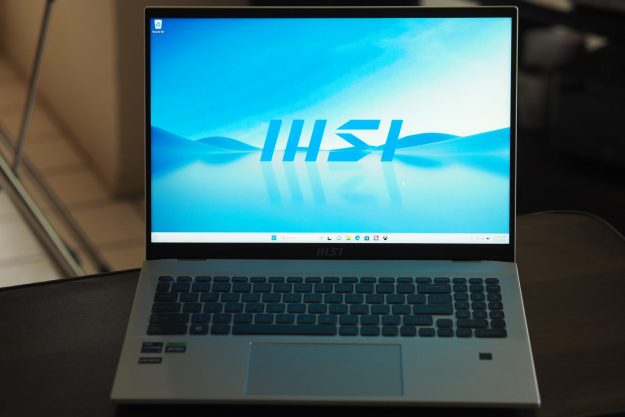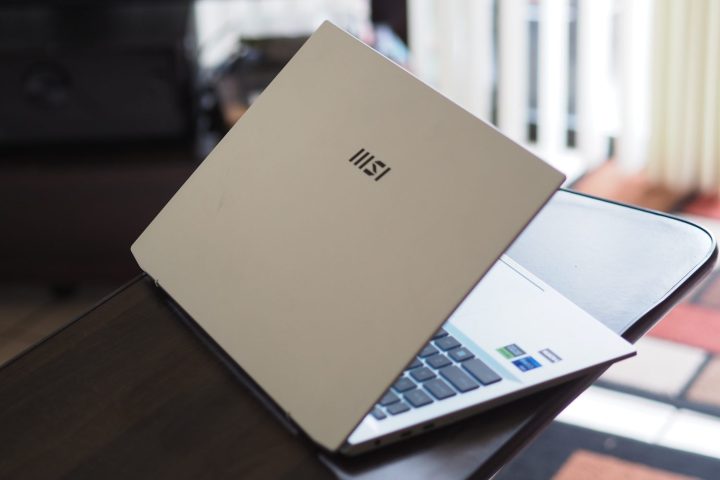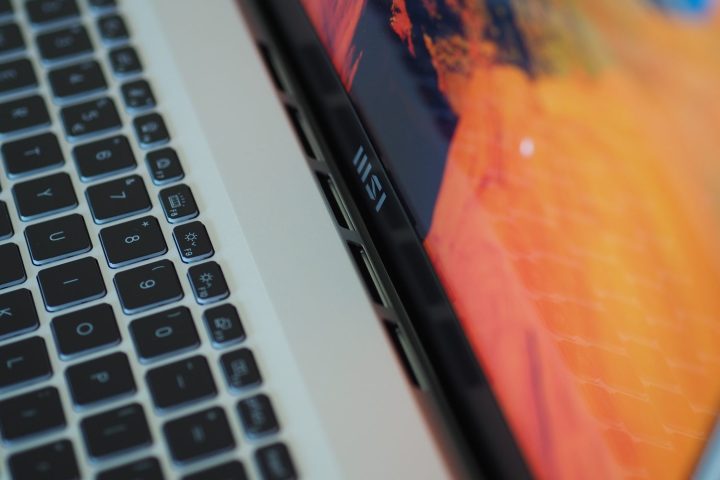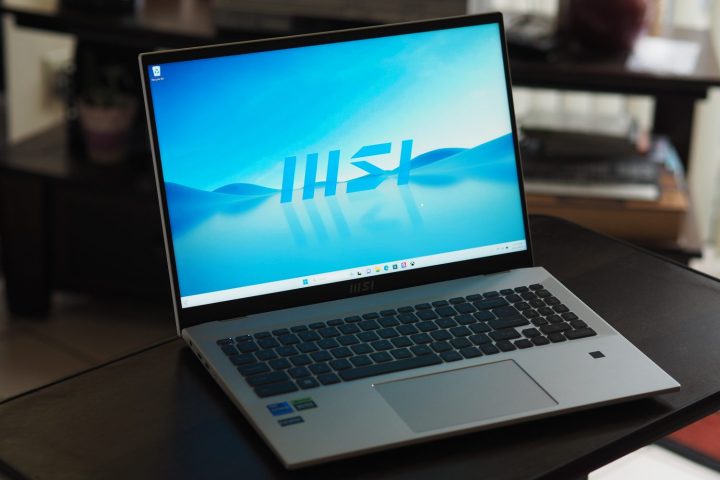
“Unstable and flawed, the MSI Prestige 16 Studio has very little to recommend about it.”
- Good gaming speeds in performance mode
- Solid build quality
- Poor performance in normal mode
- Loud and hot in performance mode
- Unstable during gaming benchmarks
- Display gives off annoying whine
- Mini-LED display disappoints
- Short battery life
It’s not often that a laptop comes across my desk in this rough of shape. The MSI Prestige 16 Studio had a lot of of promise too, sporting the latest RTX 40-series graphics and even a mini-LED display.
MSI has been wanting to break into the professional and creator space for a while, and at a glance, and I was hoping the Prestige 16 Studio would finally fit the bill. It certainly looked the part on paper.
But as I began testing, I was left with disappointment after disappointment, finally resulting in my conclusion that this is a laptop that needs to return to the drawing board.
Specs and configurations
| MSI Prestige 16 Studio | |
| Dimensions | 14.09 inches x 10.18 inches x 0.66 inches |
| Weight | 4.63 pounds |
| Processor | Intel Core i7-13700H |
| Graphics | Intel Iris Xe Nvidia GeForce RTX 4050 Nvidia GeForce RTX 4060 |
| RAM | 16GB LPDDR5-4800 32GB LPDDR5-4800 |
| Display | 16.0-inch QHD+ (2,560 x 1,600) IPS, 165Hz 16.0-inch QHD+ (2,560 x 1,600) Mini-LED, 165Hz |
| Storage | 1TB PCIe 4 SSD 2TB PCIe 4 SSD |
| Touch | No |
| Ports | 2 x USB-C 3.2 Gen 2 with Thunderbolt 4 1 x USB-A 3.2 Gen 2 1 x HDMI 2.1 1 x 3.5mm audio jack 1 x microSD card reader |
| Wireless | Wi-Fi 6E and Bluetooth 5.3 |
| Webcam | 1080p with infrared camera for Windows 11 Hello support |
| Operating system | Windows 11 |
| Battery | 82 watt-hour |
| Price | $1,300+ |
The Prestige 16 Studio comes in multiple configurations. The entry-level machine costs $1,300 for an Intel Core i7-13700H CPU, 16GB of RAM, a 1TB SSD, a 16.0-inch IPS display, and Intel Iris Xe graphics. At the high end, which I tested, you’ll spend $2,100 for the same Core i7, 32GB of
That’s a relatively affordable price, given the high-end components. Again, that had me excited for the potential of the Prestige 16 Studio on paper — but when it came to actual hands-on testing, it was problem after problem.
A disappointing mini-LED display

I was excited to review the Prestige 16 Studio in part because it’s equipped with the first Mini-LED we’ve tested on a Windows laptop. Apple’s version that it uses in its latest MacBook Pro machines is excellent, with tremendous brightness (especially with HDR content), excellent colors, and the same kind of inky blacks as OLED. Simply put, I was very disappointed in MSI’s mini-LED display by comparison, even when I first turned on the laptop. The image didn’t seem much better than a standard IPS display. But things went downhill from there.
To begin with, the display gives off a noise that sounds a lot like coil whine. It gets louder as the display’s brightness increases. The second machine that MSI sent me also had the same whine, and MSI confirmed that this is common to the machine. Whether it would bother you depends entirely on how sensitive you are to noises like that, but it was a big turn-off for me.
Next, MSI provides a utility to tune the colors for various applications, such as sRGB, AdobeRGB, DC3, etc. Usually, these utilities are turned off from the factory and a default calibration is used that doesn’t apply any tuning. I typically keep the utility turned off when testing with my colorimeter. The MSI utility, though, doesn’t seem to work that way. You have to choose one of the modes, and they all significantly change how the display looks and tests. I found the AdobeRGB setting to be the most attractive and likely the one that creators will choose, and I used that one for testing. I did test with a few other settings, and some display attributes were better and some were worse.
My colorimeter confirmed my subjective observations. Brightness was fine, and when I turned on
Overall, the display is fine for productivity work and consuming
| Brightness (nits) |
Contrast | sRGB gamut | AdobeRGB gamut | Accuracy DeltaE (lower is better) |
|
| MSI Prestige 16 Studio (Mini-LED) |
455 | 3,140:1 | 98% | 82% | 3.46 |
| Apple MacBook Pro 14 (Mini-LED) |
511 | 35,450:1 | 100% | 89% | 1.21 |
| Dell XPS 17 9730 (IPS) |
501 | 1,570:1 | 100% | 100% | 1.33 |
| Lenovo Yoga 9i Gen 8 (OLED) |
395 | 27,510:1 | 100% | 96% | 0.79 |
| Apple MacBook Air M2 (IPS) |
486 | 1,310:1 | 100% | 90% | 1.08 |
Aggressive tuning for Jekyll and Hyde performance

Performance was the other major issue I ran into while testing the MSI Prestige 16 Studio.
Most manufacturers now include utilities to tune the CPU and GPU for a variety of uses. I test
In balanced (or normal) mode, which does keep the fans quieter and the chassis cooler, the Prestige 16 Studio is slow for a laptop with the Core i7-13700H. That’s a 45-watt CPU with 14 cores (six Performance at 5GHz and eight Efficient at 3.7GHz) and 20 threads, and it’s provided fairly consistent performance in the other

In performance mode, the laptop was much faster and competitive with the rest of our comparison group. It didn’t take the lead in any benchmarks, but it wasn’t downright slow either. However, the fans spun up dramatically and were very loud, and the chassis got quite warm. It seems that MSI’s thermal system just doesn’t seem up to the task, which would explain the aggressively slow tuning in normal mode and the unimpressive showing in performance mode.
Overall, the Prestige 16 Studio’s productivity and creativity performance is underwhelming in balanced mode, and there’s a real cost in heat and noise when turning on performance mode.
| Geekbench (single / multi) |
Handbrake (seconds) |
Cinebench R23 (single / multi) |
Pugetbench Premiere Pro |
|
| MSI Prestige 16 Studio (Core i7-13700H) |
Bal: 1,880 / 6,951 Perf: 1,903 / 11,945 |
Bal: 139 Perf: 80 |
Bal: 1,797 / 7,959 Perf: 1,921 / 13,647 |
Bal: 668 Perf: 865 |
| Dell XPS 15 (9530) (Core i7-13700H) |
Bal: 1,787 / 11,978 Perf: 1,830 / 11,769 |
Bal: 79 Perf: 76 |
Bal: 1,865 / 13,386 Perf: 1,868 / 13,927 |
Bal: 866 Perf: 1,023 |
| Dell XPS 17 (9730) (Core i7-13700H) |
Bal: 1,901 / 12,654 Perf: 1,928 / 12,911 |
Bal: 79 Perf: 71 |
Bal: 1,933 / 13,384 Perf: 1,912 / 15,462 |
Bal: 760 Perf: 848 |
| Samsung Galaxy Book3 Pro 360 (Core i7-1360P) |
Bal: 1,800 / 8,960 Perf: 1,781 / 9,071 |
Bal: 109 Perf: 99 |
Bal: 1,711 / 8,389 Perf: 1,750 / 9,182 |
Bal: N/A Perf: N/A |
| Apple MacBook Pro 14 (M2 10/38) |
Bal: 1,973 / 14,596 Perf: N/A |
Bal: 85 Perf: N/A |
Bal: 1,608 / 14,789 Perf: N/A |
Bal: 1,093 Perf: N/A |
The Prestige 16 Studio is also the first laptop we’ve tested with the RTX 4060 GPU, and again its benchmark results were heavily impacted by performance mode. This was most evident in Assassin’s Creed Valhalla, where it outperformed the RTX 4070
The laptop did demonstrate a major issue, however: When I switched into performance mode and ran a benchmark again after running in normal mode (with some time in between to let the system cool down), the Prestige 16 Studio locked up in what appeared to be a thermally throttled state, with the fans spinning at full speed. Benchmarks ran like slideshows, with frames per second (fps) in the single digits. I had to reboot the laptop and run the benchmarks again in performance mode to get the results listed in the table. This was consistent across all the games I used to benchmark, and even happened with a second evaluation unit that MSI sent me.
If MSI ever fixes this instability, the Prestige 16 Studio could be a solid 1080p gaming laptop that can run some newer titles in 1440p with decent graphics. Again, you’ll have to put up with very loud fans and a warm chassis though.
| Assassin’s Creed Valhalla (1080p/1200p Ultra High) |
Cyberpunk 2077 (1080p/1200p Ultra) |
Civilization VI (1080p Ultra) |
3DMark Time Spy |
|
| MSI Prestige 16 Studio (RTX 4060) |
Bal: 35 fps Perf: 108 fps |
Bal: 64 fps Perf: 74 fps |
Bal: 105 fps Perf: 131 fps |
Bal: 7923 Perf: 7386 |
| Dell XPS 15 (9530) (RTX 4070) |
Bal: 65 fps Perf: 105 fps |
Bal: 60 fps Perf: 60 fps |
Bal: 131 fps Perf: 137 fps |
Bal: 7,077 Perf: 7,632 |
| Dell XPS 17 (9730) (RTX 4070) |
Bal: 88 fps Perf: 94 fps |
Bal: 75 fps Perf: 77 fps |
Bal: 155 fps Perf: 159 fps |
Bal: 9,639 Perf: 9,535 |
| MSI Creator Z17 HX Studio (RTX 4070 Ti) |
Bal: 66 fps Perf: 101 fps |
Bal: 61 fps Perf: 90 fps |
Bal: 149 fps Perf: 191 fps |
Bal: 10,186 Perf: 11,630 |
| HP Envy 16 (RTX 3060) |
Bal: 70 fps Perf: 71 fps |
Bal: 40 fps Perf: 41 fps |
Bal: 125 fps Perf: 132 |
Bal: 7,645 Perf: 8,040 |
Unimpressive longevity

You don’t expect a laptop with a powerful CPU and a large, high-resolution Mini-LED display to provide excellent battery life, unless it’s the Apple MacBook Pro 16 which breaks all the rules. The Prestige 16 Studio performed even worse than I expected, however, with its relatively small 82 watt-hour battery likely contributing.
It lasted just 5.25 hours in our web-browsing test, six hours in our video-looping test, and six hours in the PCMark Applications battery benchmark. All of these are poor scores even compared to other
You’ll need to carry the power brick around with you if you want to get work done beyond a few hours.
A pedestrian design

The Prestige 16 Studio is constructed of aluminum and demonstrates rigidity everywhere but the display, which is a bit bendable. It’s not quite up to par with
The screen bezels aren’t nearly as narrow as you’ll find on Dell’s XPS

The keyboard sports large keycaps and tons of key spacing, even with the numeric keypad. I found the switches light and snappy, with a precise response that didn’t quite live up to the XPS or MacBook keyboards. Nevertheless, it was a good keyboard for comfortable long-term typing sessions. The touchpad is large and smooth, with firm, quiet clicks.
Connectivity is a strength, with both Thunderbolt 4 ports for future-proofing and a couple of legacy ports. The microSD card reader is welcome, but a full-size version would have been more useful for creators. Wireless connectivity is up to date.
The webcam is 1080p, which is becoming the standard on modern
Too many issues to recommend
Between the inconsistent performance, instability, and unnerving display whine, the Prestige 16 Studio is a laptop to avoid. Toss in the underwhelming performance of its mini-LED display, and the machine is one of the most disappointing I’ve reviewed in quite some time.
If MSI can resolve these issues, then at its $2,100 price, the Prestige 16 Plus could be a contender. But as it is, it’s far too flawed.
Editors' Recommendations
- The ThinkPad X1 Carbon Gen 11 is both faster and longer-lasting
- MacBook Pro M2 Pro/M2 Max buying guide: how to make the right choice
- CES 2023: The Zenbook Pro 16X is looking like a serious MacBook Pro alternative
- Dell XPS 15 vs. Apple MacBook Pro 16
- Surface Laptop Studio to get this killer MacBook Pro feature





